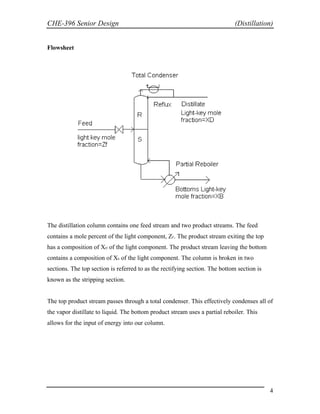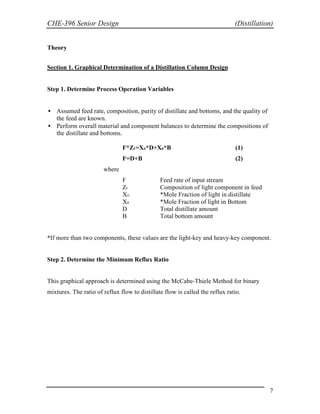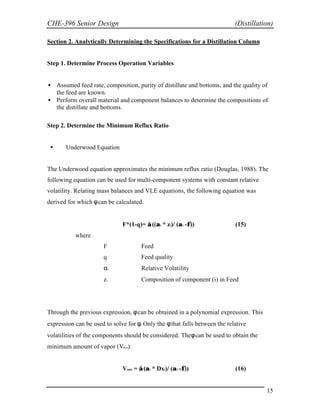This document provides an overview of distillation theory and design. It discusses the necessary components, calculations, and graphical method (McCabe-Thiele diagram) to determine the minimum reflux ratio and number of trays for a distillation column. The method involves drawing operating lines on a diagram with the vapor and liquid compositions to intersect the equilibrium curve and determine the minimum reflux ratio. The actual design reflux ratio is typically 20% higher for optimal costs. Stepping lines between the operating lines and equilibrium curve provides the minimum number of trays.

















![CHE-396 Senior Design (Distillation)
18
Step 5. Determine Actual Number of Trays:
This is determined by taking the quotient of the number of theoretical trays to the tray
efficiency. Typical values for tray efficiency range from 0.5 to 0.7 (Douglas, 1988).
These values depend on the type of trays being used, as well as the internal liquid and
vapor flow rates.
Nactual = N/ε (21)
Step 6. Principal Dimensions of the Column (Diameter/Height):
• A design guideline that should be used is that the height of the column should
not be higher than 175 feet.
• Height-to-diameter ratio should be less than 20 to 30.
• Packed towers are used when the column has a small diameter (1.5 ft or less)
or area (1.77 ft2
or less) rather than plate towers.
• Either plate or packed towers may be used when the column diameter is
between 1.5-4.5 ft (or area, 1.77-15.9 ft2
).
• If the tower is higher than 190 ft, then a design with smaller tray spacing
should be considered (Douglas, 1988).
• Height of Column
The tower height can be related to the number of trays in the column. The following
formula assumes that a spacing of two feet between trays will be sufficient including
additional five to ten feet at both ends of the tower. This includes a fifteen percent excess
allowance of space (Douglas, 1988).
Htower = 2.3 Nactual [ft] (22)](https://image.slidesharecdn.com/distillationdesign-230212203123-cf7ac3e3/85/distillation-design-pdf-18-320.jpg)











